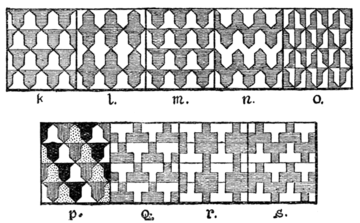sion lines are drawn, after the same manner, as nebuly. There does not seem to have been any fixed proportion for the number of rows of vair, as Fig. 40 shows the arms of the same Earl as represented upon his seal. The palpable pun upon the name which a shield vairé supplied

Fig. 39.
no doubt affords the origin of the arms of Ferrers. Some families of the name at a later date adopted the horseshoes, which are to be found upon many Farrer and Ferrers shields, the popular assumption being that they are a reference to the "farrier" from whom some would derive the surname. Woodward, however, states that a horseshoe being the badge of the Marshalls, horseshoes were assumed as armes parlantes by their descendants the Ferrers, who appear to have borne: Sable, six horseshoes argent. As a matter of fact the only one of that family who bore the horseshoes seems to have been William de Ferrers, Earl of Derby (d. 1254), as will be seen from the arms as on his seal (Fig. 41).


